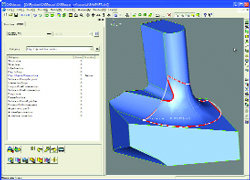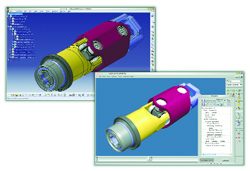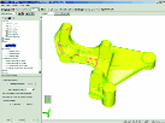Latest News
April 1, 2005
By David Prawel
In this first of a two-part series, we explore the key technicalfactors to developing an effective MCAD interoperability strategy. Ouraim is to provide insight and guidance; in Part Two we’ll discuss thebusiness considerations that will help crystallize your strategy.
AnyMCAD user or supervisor is well aware of the challenges of MCADinteroperability. For that matter, it’s a safe bet that most of us havefelt the effect of bad MCAD data, whether in the engineering team or onthe supply chain.
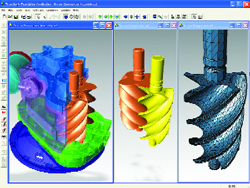
This view of a TransMagic exchange shows a compressor assembly withtransparent parts, a view with “screws” exported, and one screw savedas an STL file for prototyping.
As competitive pressures drive more outsourcing, smaller firms areturning to Asia and Eastern Europe for essential product developmentpartnerships. And, as products are becoming increasingly complex, USmanufacturers are going offshore in growing numbers for their criticalproduct designs. As a result, and more than ever before, US engineersneed to be able to collaborate with highly trained engineers overseas.
To compete in this culture, manufacturers must innovate faster than thecompetition, and produce products of higher quality. Their successdepends on how well international business partners collaborate andreact to changes in design and process. It means communicating moreefficiently to synchronize revisions and turn faster design cycles, butit cannot happen without effective MCAD interoperability.
From a technology perspective, there are three main areas to considerwhen developing sound data exchange for interoperability: the intendeduse of the data, data complexity, and its quality requirements.
The first and most important consideration in building an effectiveinteroperability strategy is the intended use of the MCAD data. Productdesigners might need to share data with other designers as they iteratetoward their best design. In this case they generally need a robusttranslator that provides as much detail of the MCAD model as possible,including features, history, and other critical design elements. Forthis class of translation, powerful software tools from experiencedvendors can achieve a high percentage of good quality translations.
This image illustrates a CATIA model that has been imported into Elysium’s CADdoctorfor interactive healing.
If the data is to be shared with other departments or individualswithin a company, then robust translators are usually best. If modelsare sent outside the company, however, then a need to protect certainproprietary data might mean confidentiality requirements would outweighrobustness requirements.
On the other hand, designers might need to share MCAD data withinternal or third-party analysis or simulation teams in engineering.These transactions usually require less robust data. For example,perhaps only the geometry, topology, and some physical properties of amodel are needed. These translations are often best accomplished byusing the translators provided with the MCAD software. Vendor-suppliedtranslators are often able to selectively translate certain parts of amodel, outputting them in a variety of third-party formats.
Since engineering analysts are not always MCAD experts, it might bewise to consider the user’s interaction with the interoperabilitytools. Some vendors, such as Elysium, specialize in highly interactivetranslation products that can be especially helpful when engineers whoare not well versed in MCAD try to repair problems in their data.
“A clear understanding of which business functions will receive theCAD data and how it will be used is the most important element of astrong interoperability strategy,” explains Doug Cheney, seniorconsultant at ITI TranscenData.
Manufacturing, rapid prototyping, and other downstream processesusually require the least robust forms of MCAD data, often only theouter surfaces of a model or its geometry. These processes also usuallyrequire relatively low precision. Often such “lean” translations can besuccessfully accomplished with industry standards like STEP, IGES, orSTL.
According to Todd Reade, president of TransMagic, “STEP files usuallygive better results than IGES files for dealing with solid models,assuming the originating and receiving CAD/CAM systems havehigh-quality STEP import and export technology.” But IGES still worksfine for a wide variety of relatively simple situations. Considergetting professional help if you aren’t experienced with STEP andyou’ll generally get a much better result.
Another factor to consider is the data’s destination application. Forexample, if a designer is collaborating on a project with a supplierwho is developing a quote, he would require a more robust translationthan if the collaboration was for feedback on the visual aspects of adesign. JT format, from UGS and the JT Open Consortium, has become aneffective and popular tool for visual collaboration, but is not robustenough for most cooperative MCAD design work.
MCAD migration is another application that requires as much of the MCADdata as possible. Any data that doesn’t translate must be recreated inthe new system, and usually at great cost. If you are changing MCADsystems or moving a lot of MCAD data to a different system for aproject, consider tools that provide feature-based interoperability.These are available from vendors like Proficiency, Theorem Solutions,and CADCAM-e. Another alternative to consider for complete model datamight be direct translators that can write MCAD files directly in theirnative format, not using indirect API-based approaches. These work wellwith older MCAD systems such as CATIA V4, but are less successful withnewer versions. CADCAM-e is a respected vendor that provides bothdirect and indirect translators.
And, if you have one, it is always important to consider how or if yourinteroperability strategy fits into your PIM/ PDM/PLM/ERP initiative.It’s important to study how users interact with data management systemsin storing, retrieving, getting approvals to send data, finding correctcontact information, and so on, before developing a strategy.
The MCAD data’s complexity is the second most important considerationwhen developing an interoperability strategy. If the data is 2D, thenIGES will usually suffice. If the model contains 2D surfaces intendedfor rapid prototyping or some machining applications, then STL willprobably suffice. If the MCAD models are fully featured 3D models, thenthe proprietary formats of the MCAD systems are probably your bestsolution, although STEP may also work, depending on considerationsmentioned earlier.
If transactions require physical properties, such as mass and surfacearea, or other information such as metadata, GDandT, annotations,coordinate systems, or ERP data (e.g., part ID, pricing), customservices will probably be required. The cost for these services wouldbe evaluated based on the amount of data that has to be translated andstandard assessments of return on investment (ROI).
Another aspect of complexity appears in engineering analysis andmanufacturing process development. These users need to be able toreorder and suppress or delete features, so the easier this can beaccomplished, the better. Engineering analysts, for example, may prefera lean translation resulting in a de-featured model. Sometimes,however, the features are required, making feature-basedinteroperability tools worth looking at.
Similarly, a manufacturing engineer developing a process plan for apart that requires many steps to manufacture will also want access tothe full feature set to reorder and rearrange process steps. Or perhapsthe part is being manufactured overseas in a facility with differenttools, skills, or materials. The success of the project could depend onthe ability to rearrange the process sequence. Again, feature-basedtranslation can prove to be a good solution because the features wouldremain intact and fully functional. Feature-based interoperability isrelatively expensive, however, so a careful examination of cost vs. ROIis essential.
It’s important to note that sometimes the best solution is to not usetechnology at all and think about process and methodology first. Then,consider how technology supports best practices. Delphi has developed aformal methodology, not software, defining a set of best practices thatare having profound impacts on manufacturing efficiency and qualityimprovement.
Assembly and part level constraints and features are exchangedparametrically between I-deas NX Series and CATIA V5 using theProficiency Collaboration Gateway.
Some companies have developed powerful tools to manage interoperabilitymethodology by helping maintain information like MCAD system andversion for transaction parties, authorized contact information,confirmations, security, and the like. For example, Datranet’sFusion-DX and OpenDXM from ProSTEP are good tools for this purpose.They can save a lot of time and cost by helping automate a methodologyso engineers can spend more time engineering and not resending MCADdata (because it never showed up or went to the wrong e-mail address,or any of the other seemingly countless pitfalls that waste time indata exchange).
CADfix prepares native MCAD models for downstream reuse,
optionally removing detail features to simplify them for simulation.
Quality Requirements
The third most important issue to weigh when building aninteroperability program is the requirement for quality in the endresult. In many applications, high quality is essential. In others,it’s not. There are two common interpretations of quality vis à visinteroperability: robustness and accuracy.
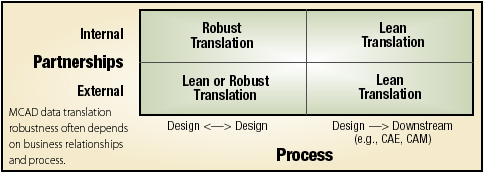
As noted earlier, a high-quality, robust translation delivers the fullmodel, features, and history included. And it’s a requirement in manysituations.
Accuracy is another very important factor. MCAD modelers work atdifferent levels of precision. Sometimes translations take placebetween two models created at the same level of precision, andsometimes between two of different levels of precision. It is importantto consider both. Decide in advance what the requirements are andmake sure the tools chosen are tested adequately in this regard.Healing software is available from numerous vendors to help repairpoor-quality (primarily in accuracy) translations. For example,CADhealer from Theorem Solutions and CADdoctor from Elysium arepossibilities; and CADfix from ITI TranscenData is a good choice torepair problems whether there are features or parameters.
In many manufacturing cases the MCAD models provide more accuracy thanthe application requires. Higher accuracy may have a negative effect onthe business process. For example, unnecessarily large file sizes mightlead to slower performance of the software. When building an effectiveinteroperability strategy, keep in mind that high levels of accuracyare not always important.
The question of how to assess the quality of translations is too largeto cover in this article. Suffice it to say that it is essential to usequality checking tools—such as CADIQ from ITI TranscenData—to assessthe robustness and accuracy of translations.
TransMagic’s Todd Reade suggests that when exchanging MCAD files, at aminimum, always “Round-trip, then zip,” to help reduce errors thatoccur when saving files in a non-native MCAD file format such as IGESor STEP. After you save the file, reopen it in the originating MCADsystem to verify and validate that the file is usable as expected.
By considering these three important aspects of data exchange (intendeduse, complexity, and quality needs) against the requirements of eachprogram and project, one can be more confident of a successful,cost-effective solution.
David Prawel is founder and president of Longview AdvisorsInc., a business, technology, and marketing consulting firm providinginsight and advice on innovation, commercialization, and processimprovement in manufacturing. You can contact him via e-mail sent to [email protected].
 You should also know that the Society of Manufacturing Engineers (SME) is holding its CAD Data Exchange—Productivity through Interoperability Conference and Exhibits in Dearborn, MI on May 11. Desktop Engineering is a proud sponsor of this event. For information and to register to attend, Visit SME’s website.
You should also know that the Society of Manufacturing Engineers (SME) is holding its CAD Data Exchange—Productivity through Interoperability Conference and Exhibits in Dearborn, MI on May 11. Desktop Engineering is a proud sponsor of this event. For information and to register to attend, Visit SME’s website.
CADCAM-e
Farmington Hills, MI
Datranet
Leeds, UK
Delphi Corp.
Troy, MI
Elysium
Southfield, MI
JT Open
Plano, TX
Proficiency
Marlborough, MA
ProSTEP
Darmstadt, Germany
Six-Sigma
Fairfield, CT
Theorem Solutions
Loveland, OH
ITI TranscenData
Milford, OH
TransMagic
Westminster, CO
UGS
Plano, TX
Subscribe to our FREE magazine, FREE email newsletters or both!
Latest News
About the Author
DE’s editors contribute news and new product announcements to Digital Engineering.
Press releases may be sent to them via [email protected].







